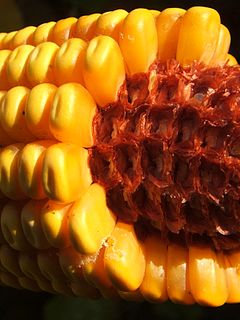
A corncob, also called cob of corn or corn on the cob, is the central core of an ear of corn. It is the part of the ear on which the kernels grow. The ear is also considered a "cob" or "pole" but it is not fully a "pole" until the ear is shucked, or removed from the plant material around the ear.

Corning Ware, also written CorningWare, was originally a brand name for a unique glass-ceramic (Pyroceram) cookware resistant to thermal shock. It was first introduced in 1958 by Corning Glass Works in the United States. The brand was later spun off with the sale of the Corning Consumer Products Company subsidiary. Glass-ceramic based Corning Ware can be taken from the refrigerator or freezer and used directly on the stovetop, in an oven or microwave, under a broiler, for table / serving use, and when ready for cleaning put directly into a dishwasher. CorningWare is sold worldwide, and it is popular in North America, Asia, and Australia.

Theileria is a genus of parasites that belongs to the phylum Apicomplexa, and is closely related to Plasmodium. Two Theileria species, T. annulata and T. parva, are important cattle parasites. T. annulata causes tropical theileriosis and T. parva causes East Coast fever. Theileria species are transmitted by ticks. The genomes of T. orientalis Shintoku, Theileria equi WA, Theileria annulata Ankara and Theileria parva Muguga have been sequenced and published.
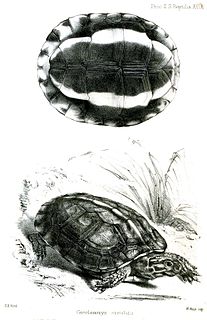
The brown wood turtle or brown land turtle is a species of turtle in the family Geoemydidae. The species is endemic to Central America and northern South America.
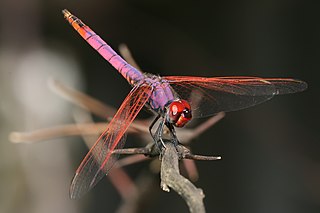
Trithemis annulata, known commonly as the violet dropwing, violet-marked darter, purple-blushed darter or plum-coloured dropwing, is a species of dragonfly in the family Libellulidae. It is found in most of Africa, in the Middle East, in the Arabian Peninsula and southern Europe. These insects are called dropwings because of their habit of immediately lowering their wings after landing on a perch. Males of this species are violet-red with red veins in the wings while females are yellow and brown. Both sexes have red eyes.

Corn fritters are fried cakes of a dough or batter made of, or containing a featured quantity of maize (corn). Originating in Native American cuisine, they are a traditional sweet and savory snack in the Southern United States, as well as Indonesia where they are known as perkedel jagung or bakwan jagung.
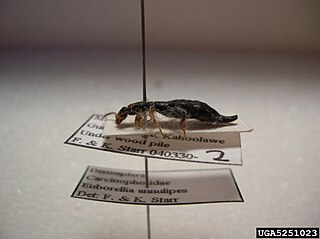
Anisolabidinae, alternatively known as Carcinophorinae, Gonolabiinae, Placolabidinae, or Titanolabiinae, is a subfamily of earwigs that contains approximately twenty-five genera. Its existence was cited by Srivastava in the book Fauna of India Pt. 2, by Chen & Ma in Fauna Sinica, and by Henrik Steinmann in The Animal Kingdom. Although Steinmann cited the subfamily's name as Carcinophorinae, this is a synonym for the taxon.
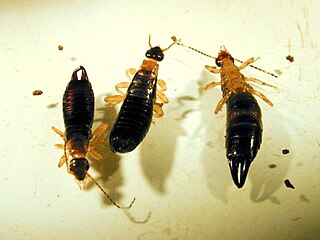
Euborellia is a genus of earwigs in the subfamily Anisolabidinae. It was cited by Srivastava in Part 2 of Fauna of India. Euborellia are small, dark-colored earwigs. Species can be difficult to distinguish from one another. There are about 50 species.

Naja annulata, commonly known as the banded water cobra or the ringed water cobra, is a species of water cobra native to western and central Africa. The species is one of the two species of water cobra in the world, the other one being the Congo water cobra.
Euborellia ambigua is a species of earwig in the family Anisolabididae.

The ringlegged earwig is a species of earwig in the family Anisolabididae.
Euborellia caraibea is a species of earwig in the family Anisolabididae.
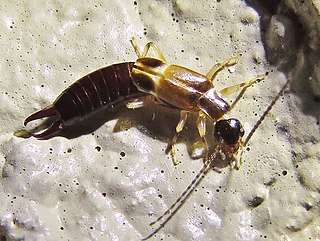
Euborellia cincticollis is a species of earwig in the family Anisolabididae.
Euborellia femoralis is a species of earwig in the family Anisolabididae.
Euborellia brunneri is a species of earwig in the family Anisolabididae.
Euborellia pallipes is a species of earwig in the family Anisolabididae.

Ostrinia furnacalis is a species of moth in the family Crambidae, the grass moths. It was described by Achille Guenée in 1854 and is known by the common name Asian corn borer since this species is found in Asia and feeds mainly on corn crop. The moth is found from China to Australia, including in Java, Sulawesi, the Philippines, Borneo, New Guinea, the Solomon Islands, and Micronesia. The Asian corn borer is part of the species complex, Ostrinia, in which members are difficult to distinguish based on appearance. Other Ostrinia such as O. orientalis, O. scapulalis, O. zealis, and O. zaguliaevi can occur with O. furnacalis, and the taxa can be hard to tell apart.

Ginataang mais is a Filipino sweet corn and rice gruel. It is also known as lugaw na mais. It is a type of dessert lugaw and ginataan. It is eaten warm in colder months, but can also be eaten cold during summer. Ginataang mais means "corn in coconut milk" in Filipino.
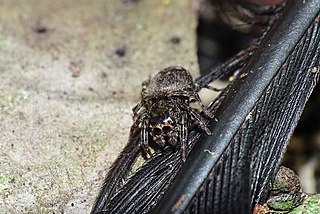
Curubis is a genus of Asian jumping spiders native to India and Sri Lanka which was first described by Eugène Louis Simon in 1902. As of 2019 it contains four species.














